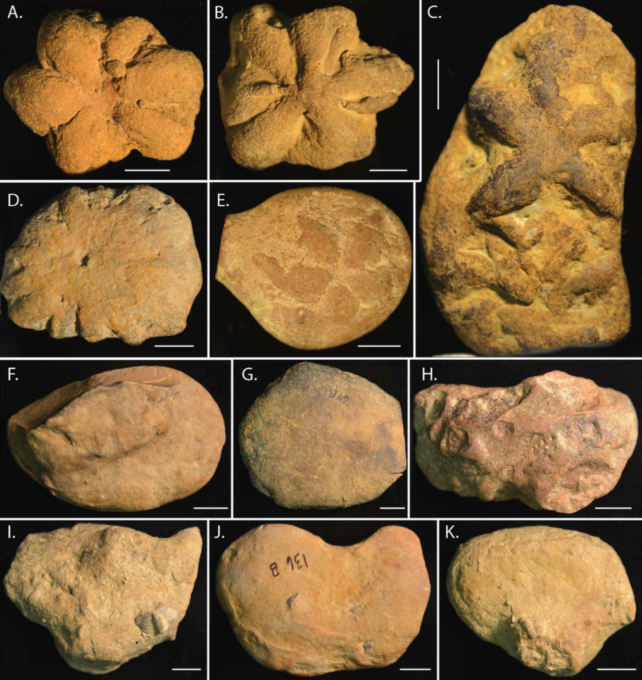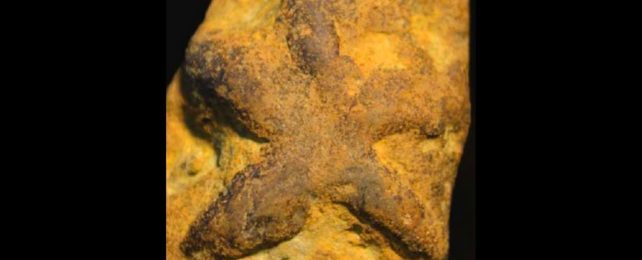An ancient three-dimensional star-shaped 'thing' still baffles scientists more than a century after its discovery.
First described in 1896 by American paleontologist Charles Doolittle Walcott as a kind of jellyfish, a number of similar radial forms have since been found in various shale deposits dating back half a billion years ago to the Cambrian.
To the untrained eye, they look sort of like bundt cakes: circular with radial lobes spreading outwards like a starfish or the spokes of a bike.
Over the years paleontologists have reevaluated the taxonomy of whatever life form may have left the fossils, progressing from speculations on jellyfish to sponges. They named it Brooksella alternata, which became a catch-all for any Brooksella-like fossil found, of which there are many.
A few examples can be seen in the image below.

Pretty much ever since Walcott first laid eyes on that tiny little rock-star, these bizarre Brooksella moldings have suffered a fundamental identity crisis.
Scientists have argued they are the remnants of burrowing worms, bulbous algae, or glass sponges.
Meanwhile, others are unconvinced these are even 'fossils', instead explaining them as gas bubbles.
Now, researchers are throwing out yet another suggestion of non-biological origins. A fresh look at Brooksella using high-resolution 3D imaging and chemical analysis suggests this is, in fact, a 'pseudofossil'.
According to a new study's authors, Brooksella is not a sponge, as is generally accepted nowadays, but an unusual form of silica. This naturally occurring mineral particle can fuse to form spherical, cubical, or hexagonal shapes.
"We found that Brooksella lacked characteristics of glass sponges, especially the opaline-fused spicules that compose the body," researchers explain.
"Nor did it grow as a sponge would be expected to over its lifetime."
What looks like Brooksella's 'mouth' is actually oriented downwards towards the sediment, making it extremely difficult to filter food from the water as sponges do.
A downward-facing mouth might make you think of a starfish, but the ancestor of all starfish is believed to have arrived on Earth's scene only 480 million years ago, tens of millions of years after the dating of bedrock where Brooksella has been found.
Burrowing worms don't seem to be a fulfilling explanation, either. While these organisms were present on Earth during the middle Cambrian, researchers found no sign that they made the star-shaped lobes.
The only explanation that made any sense came when experts compared Brooksella to other concrete silica shapes made in different Cambrian rock beds around the world.
"We did not find any difference between Brooksella and the concretions, other than Brooksella had lobes and the concretions did not," the researchers write.
"We thus concluded that Brooksella was not part of early sponge diversification in middle Cambrian seas, but rather, was an unusual type of silica concretion. Concretions can be all kinds of shapes to the point some look like they were organically formed."
On Mars, for instance, silica-rich rocks can form flower-shaped petals. And here on Earth, lightning can shock underground sand into a branching, crystallized form called a fulgurite.
"Brooksella intrigued me because, unlike most fossils, it had a 3D shape like a star-shaped puffed pastry that is unusual for soft-squishy animals like a sponge," explains paleontologist Sally Walker from the University of Georgia.
"A sponge usually gets flattened like roadkill during the fossilization process—especially a fossil more than 500 million years old! Also puzzling was the fact that no one inspected Brooksella where it lived and its orientation; if they did, they would find that most lobes were oriented downward, which does not make sense for a sponge to be eating mud."
But that doesn't mean researchers have solved all of Brooksella's mysteries. It's still unclear, for instance, why so many strange concretions with the same shape have been found in this one region of the world.
These objects look quite similar on the outside, but when researchers examined their internal dynamics using microCT scanning, they found they were all inherently quite different.
Further research will be needed to figure out how they actually formed.
"While the applications for microCT have been nearly endless in the materials sciences and engineering fields, its capacities for elucidating the fossil record are really just beginning to be explored," says geologist James Schiffbauer from the University of Missouri.
"This project is an excellent example of the types of fossil mysteries we can solve with applications of microCT."
The study was published in PeerJ.
